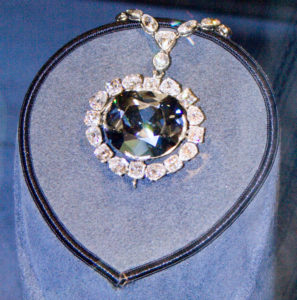Revealing a New Facet of the Hope Diamond

By David Bjorgen – Own work, CC BY-SA 3.0
From disappearing acts to legendary curses, the Hope Diamond has often been found embedded in the center of a good story – often, one shrouded in mystery. For centuries, speculation regarding the unique qualities of this stunning 45.52 carat stone (now in the possession of the Smithsonian National Museum of Natural History’s Gem and Minerals department) have abounded – and questions sparked by the recent discovery of the diamond’s unusual phosphorescent qualities are no exception.

Jeffery Post, Research Geologist in the Department of Geology Gems, and Minerals at the Smithsonian National Museum of Natural History.
Dr. Jeff Post, curator of the United States National Gem and Mineral Collection, describes the effect of exposure to ultra-violet light on the Hope Diamond as leaving a residual phosphorescence which resembles “a glowing orange coal”. It was this quality which inspired researchers to delve deeper into the examination of this famous stone.
A team of expert scientists and researchers were invited to study the effects of ultra-violet light on several of the rarest stones in the Smithsonian collection – specifically, an assortment of blue-hued diamonds – in order to determine whether this quality was unique to the Hope Diamond, or shared by other specimens. What they discovered was that exposure to the mineral boron (the same element which provides these diamonds with their stunning blue coloring) results in red phosphorescence in all natural blue diamonds.
Not surprisingly, further examination also revealed a new mystery – each stone’s pattern of phosphorescence is entirely unique to the individual, resulting in a one-of-a-kind “fingerprint” which may be used to identify each specimen. The reasons behind this phenomenon, of course, remain unclear – but researchers hope that further study of the Hope Diamond may reveal more information.
Until then – it is simply one in a long line of mysteries surrounding this legendary stone.
To read more of The Smithsonian’s research into this phenomenon, click here. Or explore information regarding other rare gems and minerals, or view the Arkenstone’s current collection of diamonds.